|

| |
The Piano
.  
CONCERT JAZZ Piano Appeal
Anyone wishing to donate a Piano to Concert Jazz
in trust or as a gift we could certainly put it to work and you can then hear it
sing as it should on a regular basis. Our pianists always prefer to play
on a real piano but normally resort to electronic keyboards. So if you wish to
hear real live jazz on a real acoustic pianoforte instrument please pass on this
appeal to anyone with a redundant instrument. Click on the above title to advise
us.
piano e forte, soft and loud: term used (c. 1710) by its
inventor, Bartolomeo Cristofori (1655-1731), of Padua,
Italy
piano + forte, soft + loud, strong
from
its gradation of tone in contrast with the harpsichord
The Piano - a brief history
The Piano is certainly the
most versatile Instrument. With it’s 88 keys it has the widest range of any
instrument. The piano can reach higher than a piccolo and lower than a bass
drum. The pianist can play both melody and accompaniment at the same time. The
piano is able to accompany virtually any other instrument. All of this from a
stately looking wooden box on legs
The first real piano didn’t come about until around 1700. The inventor was
a maker of harpsichords in Florence, Italy by the name of Bartolomeo Cristofori.
By adding different groups of strings to the harpsichord Cristofori was able to
extend the range of the harpsichord. But it wasn’t until he made up small
hammers that struck the strings rather than plucking them that a real
breakthrough came about. Now the player could control the sound of each note by
the force with which he struck the key. He could accent the notes and had the
whole range from piano (soft) to forte (loud) to draw from. Cristofori called
his new invention gravicembalo coi piano e forte which meant ‘harpsichord with
soft and loud.’ Happily, this was later reduced to piano forte and
finally simply piano.
Cristifori’s new invention, however, did not catch the public imagination
and he soon returned to making harpsichords. It was up to others to refine the
developments over the next 100 or so years. The first public piano performance
was given in 1777 by Johann Christian Bach, son of the great Johann Sebastian
Bach.
However, it was the Austrian composer Wolfgang Amadeus Mozart who took
piano music to the next level. Mozart wrote his first piano concerto at age 11.
His favourite pianos were those made by skilled German piano maker Johann A.Stein.
Along with Ludwig Van Beethoven, Mozart created music specifically for the piano
that demanded the best out of both performer and instrument. Beethoven was known
to attack the piano with such force that keys and strings were liable to go
flying.
As pianists demanded more
and more from their instruments, manufacturers built larger and heavier frames
to support the higher string tension that was desired. The one-piece cast iron
frame, developed in 1825, was a great advancement in this area. By 1880 the
piano had developed into the instrument we know today.
The history of the piano,
then, revolves around the life’s work of some very skilled individuals –
Bartolomeo Christofori, Wolfgang Amadeus Mozart, Ludwig Van Beethoven, Johann
Stein…and - in the end - a series of masterly Jazz Exponents
Nottingham National Jazz Piano Competition - Judges
Applications are now closed
Jelly Roll Morton
Lemott; La Menthe; La
Mothe; Ferdinand Joseph (1890-1941) Composer and pianist
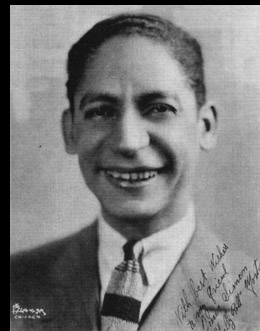 His
publicity photos claimed he was the 'originator of jazz and stomps', an example
of the kind of outrageous and colourful statement frequently associated with
this most colourful of jazz characters. Morton was born in New Orleans, and he
grew up in that City's creole society. His
publicity photos claimed he was the 'originator of jazz and stomps', an example
of the kind of outrageous and colourful statement frequently associated with
this most colourful of jazz characters. Morton was born in New Orleans, and he
grew up in that City's creole society.
After leaving his hometown in 1907 to become a wandering pianist, he
seldom returned there, yet his subsequent music was to include some of the most
brilliant examples of what is now known as New Orleans jazz. From 1907-1922 he
criss-crossed the United States, drawing in a wide range of musical influence,
and becoming fully aware of the emergence of jazz.
By the end of that period, he was based on the West Coast, where he not only
played, but began publishing his compositions. In 1923 he moved to Chicago and
soon began a series of outstanding recordings both as a pianist and with various
bands.
His solo piano work marks a vital phase in the transition from ragtime to
jazz, but Morton also incorporated many of the rhythmic ideas of his Hispanic
Creole heritage. His band discs, notably those from 1926-7 with his Red Hot
Peppers, are classic examples of the New Orleans ensemble style, with trumpet,
clarinet and trombone parts weaving together in collective improvisation.
In the early 1930s, Morton drifted into
obscurity. He settled in Washington, DC, where he managed a jazz club and also
played intermittently. In 1938, the folklorist Alan Lomax, later Morton's
biographer, recorded him in an extensive series of interviews held at the
Library of Congress (issued on disc in 1948 and reissued in 1957). In this
invaluable oral history, Morton recalled in words and performances his early
days in New Orleans, recreating the styles of many of his turn-of-the-century
contemporaries. His accounts, both verbal and pianistic, have the ring of
authenticity and revealed Morton as jazz's earliest musician-historian and a
perceptive theorist and analyst of the music. The Library of Congress recordings
rekindled public interest in Morton, eventually leading to further recording
sessions in 1939-40 and, in tandem with the New Orleans revival, a renewed
career. This was cut short in 1940, however, owing to his ill health. His vocal
delivery was eerily close to that of George Melly. His diamond studded smile was
stolen on his death and his nickname Jelly Roll referred to his favoured sexual
proclivity.
Jelly Roll Morton Bio
Fats Waller
 Thomas
Wright (1904-1943) Pianist, organist, singer, bandleader, and composer Thomas
Wright (1904-1943) Pianist, organist, singer, bandleader, and composer
Fats Waller's father, Edward Waller, was a Baptist lay preacher who conducted
open air religious services in Harlem, at which as a child Waller played reed
organ. He played piano at his public school and at the age of 15 became organist
at the Lincoln Theatre on 135th Street. His father hoped that Waller would
follow a religious calling rather than a career in jazz, but after the death of
his mother Adeline Waller in 1920, he moved in with the family of the pianist
Russell B. T. Brooks. Waller met James P. Johnson, under whose tutelage he
developed as a pianist and through whose influence he came to make piano rolls
There is some evidence to support Waller's claims that during his formative
years as a pianist he studied with Leopold Godowsky and composition with Carl
Bohm at the Juilliard School
In 1938, Waller undertook a
European tour, recording in London with his Continental Rhythm, as well as
making solo pipe-organ recordings for HMV. His second European tour in 1939 was
terminated by the outbreak of war, but while in Britain, he recorded his
London Suite, an extended series of six related pieces for solo piano:
Piccadilly, Chelsea, Soho, Bond Street, Limehouse,
and White Chapel. It is Waller's longest composition and represents
something of his aspirations to be a serious composer rather than just the
author of a string of hit songs. He died aged 39 from pneumonia while on a train
to New York - Hip Dude
 WILSON,
THEODORE SHAW (1912-1986). Teddy Wilson,
jazz pianist, was born in Austin, Texas, on November 24, 1912, the second son of
James and Pearl Wilson. In 1918 he and his family moved to Tuskegee, Alabama,
where his mother worked as a librarian and his father taught English at the
Tuskegee Institute. Wilson attended the institute, where he studied piano and
violin; he also played the E-flat clarinet and oboe in the school band. He
attended Talladega College for a year, but moved to Detroit in 1929 to earn his
living as a musician. Wilson played in a band with Speed Webb in the Detroit
area from 1929 to 1931. In 1931 he moved to Chicago, where he had the good
fortune to play alongside Erskine Tate, Louis Armstrong, and Jimmy Noone. He
joined the Benny Carter band in 1933 and made several recordings. Wilson's big
break came in 1936, when he began touring with Benny Goodman and Gene Krupa,
making the trio one of the first interracial groups to perform in the United
States. Crowds at that time cheered Wilson on the bandstand, but he still had to
stay at the "colored" hotels. Between 1935 and 1939 Wilson also performed with
soloists from the Count Basie and Duke Ellington bands, as well as with vocalist
Billie Holiday; during this time he recorded on the Brunswick label. He formed
his own band and worked with CBS studios in the 1940s and 1950s, and he taught
piano at the Juilliard School of Music from 1945 to 1952. He also appeared in
The Seven Lively Arts and in the movie The Benny Goodman Story
(1956). Wilson brought to jazz an elegance and sophistication that it had not
previously enjoyed. He drew elements from Fats Waller, Earl Hines, and Art
Tatum, blending and refining them into his own unique sound. His style was
subtle and disciplined, providing an effective contrast when he accompanied
artists like Billie Holiday, who usually sang just outside the beat.
Characteristics of Wilson's music included short, single-note phrases, tenth
chords in the left hand, and a wonderfully provocative use of dissonance. His
talent at improvisation let him create intricate counterpoint lines that
complimented whichever soloist he was performing with. Wilson rejoined Benny
Goodman's group for tours of Scandinavia in 1952, England in 1953, Australia in
1960, Europe in 1965, several trips to Japan in the 1970s, and a concert at
Carnegie Hall in 1982. He died on July 31, 1986, in New Britain, Connecticut,
after a lengthy illness. WILSON,
THEODORE SHAW (1912-1986). Teddy Wilson,
jazz pianist, was born in Austin, Texas, on November 24, 1912, the second son of
James and Pearl Wilson. In 1918 he and his family moved to Tuskegee, Alabama,
where his mother worked as a librarian and his father taught English at the
Tuskegee Institute. Wilson attended the institute, where he studied piano and
violin; he also played the E-flat clarinet and oboe in the school band. He
attended Talladega College for a year, but moved to Detroit in 1929 to earn his
living as a musician. Wilson played in a band with Speed Webb in the Detroit
area from 1929 to 1931. In 1931 he moved to Chicago, where he had the good
fortune to play alongside Erskine Tate, Louis Armstrong, and Jimmy Noone. He
joined the Benny Carter band in 1933 and made several recordings. Wilson's big
break came in 1936, when he began touring with Benny Goodman and Gene Krupa,
making the trio one of the first interracial groups to perform in the United
States. Crowds at that time cheered Wilson on the bandstand, but he still had to
stay at the "colored" hotels. Between 1935 and 1939 Wilson also performed with
soloists from the Count Basie and Duke Ellington bands, as well as with vocalist
Billie Holiday; during this time he recorded on the Brunswick label. He formed
his own band and worked with CBS studios in the 1940s and 1950s, and he taught
piano at the Juilliard School of Music from 1945 to 1952. He also appeared in
The Seven Lively Arts and in the movie The Benny Goodman Story
(1956). Wilson brought to jazz an elegance and sophistication that it had not
previously enjoyed. He drew elements from Fats Waller, Earl Hines, and Art
Tatum, blending and refining them into his own unique sound. His style was
subtle and disciplined, providing an effective contrast when he accompanied
artists like Billie Holiday, who usually sang just outside the beat.
Characteristics of Wilson's music included short, single-note phrases, tenth
chords in the left hand, and a wonderfully provocative use of dissonance. His
talent at improvisation let him create intricate counterpoint lines that
complimented whichever soloist he was performing with. Wilson rejoined Benny
Goodman's group for tours of Scandinavia in 1952, England in 1953, Australia in
1960, Europe in 1965, several trips to Japan in the 1970s, and a concert at
Carnegie Hall in 1982. He died on July 31, 1986, in New Britain, Connecticut,
after a lengthy illness.

Jess Stacy,
changed forever the way jazz piano was perceived.
On that night, and until the twelve minute long version of Sing Sing Sing ( With
A Swing) came along near the end of the concert Stacy had played his normal role
of laying down chords, plus the odd honky tonk inspired solo. No one - and I
suspect not even the pianist himself - was prepared for the extraordinary solo
that Stacy came up with on this old Louis Prima war horse (cleverly stitched
together by arranger Jimmy Mundy with Redman’s Christopher Columbus) that has
now gone down in jazz history.
The piece starts with drummer Gene Krupa laying down a hard tom tom pattern that
ushers in the brass and sax sections blowing wild counter riffs kicked along by
some beautifully executed double and triple time rim shots from Krupa (a man who
changed drumming forever too, but more of him some other time), until the
orchestra are forced to rest seemingly out of sheer exhaustion that signals in a
pretty mundane solo from tenor sax player Babe Russin, whose lips must have been
giving out by this stage, followed by a short solo from Harry James on trumpet,
whose lips never seemed to give out, and a gentle solo from Goodman himself on
clarinet which is a master class in scales, ending on a barely audible high C.
At this point Krupa ( who is doing the drummers version of running on the spot)
obviously looks at Stacy, and with a ” yes Jess” opens the door for the
pianist’s solo which Krupa probably thought was going to be yet another
barrel-house work-out. Not this time it wasn’t.
Actually it starts that way and Krupa is obviously waiting for Stacy’s nod to
get the piece out of the way and head down town to drink away what’s left of
Sunday. But no, this time Stacy is inspired and soon throws out the honky tonk
replacing it with some dreamy Debussy like phrases that Krupa - taken by
surprise but with a smile on his handsome face - simply backs up with the
quietest 4/4 engine you’ve ever heard that is like a child’s heart beat (
elasticated slightly by Harry Goodman’s bass) and just sits back to listen, as
does the audience in something close to awe.
From Debussy Stacy takes us on a piano journey which, via a bluesy Chopin, takes
us into the jazz future with some beautiful forward echoes of Errol Garner,
Thelonious Monk, and just about every other jazz player of the past sixty years.
It is an extraordinary piece of on-the-hoof composing that can, if you listen
too carefully, take your breath away. It sounds as if Stacy is almost saying
goodbye to the music world as the solo fades away and, God bless him, Krupa just
keeps beating time to allow the audience to show their appreciation, which comes
over in wave after wave of applause. And only when the applause begins to die
does Krupa throw all caution to the wind, winding up proceedings with a drum
solo that sends smoking musical shells through the roof of Carnegie Hall itself.
A little bit of history has been made.
Stacy did give up music, ending up in California working for Max Factor. That is
until the 1950 recording of the concert came out and there was renewed interest
in the man’s playing, and a realisation that he was a genius. The concert
is available on a double CD. Buy it.
 Art
Tatum was born Oct. 13, 1909 in Toledo, Ohio and despite
being blind in one eye and only partially sighted in the other he became
arguably the greatest jazz piano player who ever lived. The
starting point of Art Tatum's style was Fats Waller's stride. As Tatum once
said, "Fats, that's where I come out of and, man, that's quite a place to come
from". From this beginning he went on to create and superbly original and
creative style of playing piano. His left-handed figures where similar to
stride but he was really known for the way that he explored harmonic
complexities and unusual chord progressions. When improvising, Tatum would
often insert totally new chord sequences (occasionally with a chord on each
beat) into one or two measures. He also developed the habit of quoting from
other melodies, something that became a standard practice among modern jazz
musicians. What really set Tatum apart was his amazing technical abilities
which combined with his willingness to explore the imagined limitations of the
orthodox keyboard which produced astonishing rhythmic and harmonic
complexities. It is claimed that he could identify the dominant note in a
flushing toilet. Perhaps the greatest tribute to the excellence of Art Tatum
lies in the opinions of his peers. His influenced many musicians including Bud
Powell, Herbie Hancock, and even non-pianists such as Charlie Parker and John
Coltrane. Many would say that he inspired the bebop revolution in jazz. When
Oscar Peterson first heard him play he thought it was two people and he
considered Tatum the best jazz instrumentalist of all time. Legend has it that
classical pianist Vladimir Horowitz was so awed by Tatum's wizardry that it
brought him to tears. Fittingly, his strongest support comes from one of his
early influences, Fats Waller. One time in 1938 Tatum dropped in to hear Waller
play at a club. By way of introduction Waller told the audience, "I just play
the piano, but God is in the house tonight."
http://www.jazzonthetube.com/page/43.html Art
Tatum was born Oct. 13, 1909 in Toledo, Ohio and despite
being blind in one eye and only partially sighted in the other he became
arguably the greatest jazz piano player who ever lived. The
starting point of Art Tatum's style was Fats Waller's stride. As Tatum once
said, "Fats, that's where I come out of and, man, that's quite a place to come
from". From this beginning he went on to create and superbly original and
creative style of playing piano. His left-handed figures where similar to
stride but he was really known for the way that he explored harmonic
complexities and unusual chord progressions. When improvising, Tatum would
often insert totally new chord sequences (occasionally with a chord on each
beat) into one or two measures. He also developed the habit of quoting from
other melodies, something that became a standard practice among modern jazz
musicians. What really set Tatum apart was his amazing technical abilities
which combined with his willingness to explore the imagined limitations of the
orthodox keyboard which produced astonishing rhythmic and harmonic
complexities. It is claimed that he could identify the dominant note in a
flushing toilet. Perhaps the greatest tribute to the excellence of Art Tatum
lies in the opinions of his peers. His influenced many musicians including Bud
Powell, Herbie Hancock, and even non-pianists such as Charlie Parker and John
Coltrane. Many would say that he inspired the bebop revolution in jazz. When
Oscar Peterson first heard him play he thought it was two people and he
considered Tatum the best jazz instrumentalist of all time. Legend has it that
classical pianist Vladimir Horowitz was so awed by Tatum's wizardry that it
brought him to tears. Fittingly, his strongest support comes from one of his
early influences, Fats Waller. One time in 1938 Tatum dropped in to hear Waller
play at a club. By way of introduction Waller told the audience, "I just play
the piano, but God is in the house tonight."
http://www.jazzonthetube.com/page/43.html
  Tatum was playing professionally
in Toledo by 1926 and performed on radio in 1929-30. In 1932, he travelled to
New York as the accompanist for Adelaide Hall. There, in March 1933, he made his
first solo recordings, for Brunswick. After leaving Hall, he worked in Cleveland
from 1934-5 and led a group in Chicago from 1935-6. His reputation as an
outstanding jazz pianist was consolidated in 1937 with his performances in
various New York clubs and on radio shows. He toured England the following year
and appeared regularly in New York and Los Angeles in the late 1930s and early
1940s. Taking Nat "King" Cole's successful jazz trio as a model, Tatum founded
his own influential trio with Slam Stewart (double bass) and Tiny Grimes
(electric guitar) in 1943. Grimes left the following year, but Tatum continually
returned to this format, playing with Everett Barksdale in particular. Tatum was playing professionally
in Toledo by 1926 and performed on radio in 1929-30. In 1932, he travelled to
New York as the accompanist for Adelaide Hall. There, in March 1933, he made his
first solo recordings, for Brunswick. After leaving Hall, he worked in Cleveland
from 1934-5 and led a group in Chicago from 1935-6. His reputation as an
outstanding jazz pianist was consolidated in 1937 with his performances in
various New York clubs and on radio shows. He toured England the following year
and appeared regularly in New York and Los Angeles in the late 1930s and early
1940s. Taking Nat "King" Cole's successful jazz trio as a model, Tatum founded
his own influential trio with Slam Stewart (double bass) and Tiny Grimes
(electric guitar) in 1943. Grimes left the following year, but Tatum continually
returned to this format, playing with Everett Barksdale in particular.
Nat King Cole
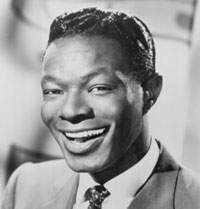 Born
Nathaniel Adams Coles on March 17, 1919 (although 1916 and 1917 have also been
cited), in Montgomery, Alabama, Cole was born into a family with a pivotal
position in the black community; his father was pastor of the First Baptist
Church. In 1921, the family migrated to Chicago, part of the mass exodus seeking
a better life in the prospering industrial towns of the north. At four years
old, he was learning the piano by ear from his mother, a choir director in the
church. At 12 years old he took lessons in classical piano, but was soon to be
bitten by the Jazz bug -- inescapable in Chicago. He left school at 15 to pursue
a career as a jazz pianist. Cole's first professional break came touring in the
revival of the show "Shuffle Along." When the show folded he was stranded in Los
Angeles. Cole looked for club work and found it at the Century Club on Santa
Monica Boulevard, where he made quite an impression. Born
Nathaniel Adams Coles on March 17, 1919 (although 1916 and 1917 have also been
cited), in Montgomery, Alabama, Cole was born into a family with a pivotal
position in the black community; his father was pastor of the First Baptist
Church. In 1921, the family migrated to Chicago, part of the mass exodus seeking
a better life in the prospering industrial towns of the north. At four years
old, he was learning the piano by ear from his mother, a choir director in the
church. At 12 years old he took lessons in classical piano, but was soon to be
bitten by the Jazz bug -- inescapable in Chicago. He left school at 15 to pursue
a career as a jazz pianist. Cole's first professional break came touring in the
revival of the show "Shuffle Along." When the show folded he was stranded in Los
Angeles. Cole looked for club work and found it at the Century Club on Santa
Monica Boulevard, where he made quite an impression.
In 1939, Cole formed a trio with
Oscar Moore on guitar and Wesley Prince on bass, notably they had no drummer.
Gradually Cole would emerge as a singer. The group displayed a finesse and
sophistication which expressed the new aspirations of the black community. In
1943, he recorded "Straighten Up And Fly Right," for Capitol Records, inspired
by one of his father's sermons. It was an instant hit, assuring Cole's future as
a pop sensation. With the addition of strings in 1946 "The Christmas Song" began
Cole's evolution into a sentimental singer. In the 1940s he made several
memorable sides with the Trio, including "It's Only A Paper Moon" and "(I Love
You) For Sentimental Reasons." But by 1948, and "Nature Boy," the move away from
small-group jazz, towards his eventual position as one of the most popular
vocalists of the day, was underway.
He died on February 15, 1965 of lung cancer aged 46.
Oscar Peterson said he was the best time keeper in the business. Oscar
Moore guitar trailblazer ended up as a bricklayer - unbelievable hands.
George Shearing
The tight trio format that Nat
perfected and with the humour that has full echoes of Fats was further
embellished by the George Shearing Quintet by the addition of Vibes and used a
locked hands or block chord style to create another unique subdued rhythm sound
with John Levy - Bass, Denzil Best - Drums, Chuck Wayne - Guitar, Marjorie
Hyams - Vibes. Shearing voiced the guitar (without vibrato) one octave
higher than the vibes (without a motor), both playing the melody in unison while
Shearing played harmonies in the block-chord style. The bass and drums remained
subdued. Cal Tjader also replaced Hyams later on vibes
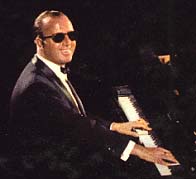 George
Shearing enjoys an international reputation as a pianist, arranger, and
composer. Equally at home on the concert stage as in jazz clubs, Shearing is
recognised for inventive, orchestrated jazz. He has written over 300
compositions, including the classic “Lullaby of Birdland”, which has become a
jazz standard. George
Shearing enjoys an international reputation as a pianist, arranger, and
composer. Equally at home on the concert stage as in jazz clubs, Shearing is
recognised for inventive, orchestrated jazz. He has written over 300
compositions, including the classic “Lullaby of Birdland”, which has become a
jazz standard.
Shearing was born in 1919 in the Battersea area of London. Congenitally blind,
he was the youngest of nine children. His father delivered coal and his mother
cleaned trains at night after caring for the children during the day. His only
formal musical education consisted of four years of study at the Linden Lodge
School for the Blind. While his talent won him a number of university
scholarships, he was forced to refuse them in favour of a more financially
productive pursuit…playing piano in a neighbourhood pub for the handsome salary
of £1.25 a week! Shearing joined an all-blind band in the 1930’s. At that time
he developed a friendship with the noted jazz critic and author, Leonard
Feather. Through this contact, he made his first appearance on BBC radio and
then moved to New York.
By the time the Classic Album
with Peggy lee - Beauty and the Beat was made the personnel changed to
Toots Thielemans - Guitar, Ray Alexander -
Vibes, Carl Pruitt - Bass. Ray Mosca - Drums, Armando Peraza - Conga
Nat Cole and Shearing had popular
success together with ''Let There be Love'
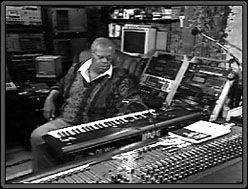 Oscar
Peterson Oscar
Peterson
Internationally renowned, Canadian
jazz pianist Oscar Peterson has entertained the world with his mastery and
prowess over the piano for over 40 years. Born in a limestone house on
Montreal's Delisle Street on August 15, 1925, he was the fourth of five children
to his parents, Daniel and Kathleen. All of the Peterson children (Fred, Daisy,
Charles, Oscar and May) were introduced to music in a good way before any of
them can remember. Their father, a porter with Canadian Pacific Railways who
learned to play piano on his own while in the merchant marine, taught his
children all he could until they achieved a certain proficiency. It was at this
point, during his high school years, that Oscar came to study with an
accomplished classical pianist, Hungarian Paul de Marky, who taught Oscar
"technique and speedy fingers". He also helped Oscar come to believe that he had
something special to give to the music world.
Some of the artists who influenced Oscar during the early years were Teddy
Williams, Nat (King) Cole, James P. Johnson and the legendary Art Tatum, who
many have tried to compare Oscar to in later years. In fact, one of Oscar's
first exposures to the musical talents of Art Tatum came early in his teen years
when his father played an Art Tatum record to him and Oscar was so intimidated
by what he heard that he didn't touch the piano for over a month.
In his last years of high school, Oscar played in a band called the Montreal
High School Victory Serenaders with trumpeter Maynard Ferguson.
Bill Evans
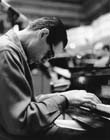 Bill
Evans was born in Plainfield, New Jersey, in 1929, of a devout Russian Orthodox
mother and an alcoholic father of Welsh origins, who managed a golf course.
Evans' Russian side accounts for the special feeling many of his Russian fans
have for him that he is one of them. Bill received his first musical training in
his mother's church; both parents were highly musical. He also held a lifelong
attachment to the game of golf. Bill began studying piano at age
six, and since his parents wanted him to know more than one instrument, he took
up the violin the following year and the flute at age 13. He became very
proficient on the flute, although he hardly played it in his later years.
Proficiency at these instruments in which great emphasis is laid on tonal
expressiveness, might have encouraged Evans to seek the similar gradations of
nuance on piano. He did, of course, thereby extending the expressive range of
jazz piano. Bill
Evans was born in Plainfield, New Jersey, in 1929, of a devout Russian Orthodox
mother and an alcoholic father of Welsh origins, who managed a golf course.
Evans' Russian side accounts for the special feeling many of his Russian fans
have for him that he is one of them. Bill received his first musical training in
his mother's church; both parents were highly musical. He also held a lifelong
attachment to the game of golf. Bill began studying piano at age
six, and since his parents wanted him to know more than one instrument, he took
up the violin the following year and the flute at age 13. He became very
proficient on the flute, although he hardly played it in his later years.
Proficiency at these instruments in which great emphasis is laid on tonal
expressiveness, might have encouraged Evans to seek the similar gradations of
nuance on piano. He did, of course, thereby extending the expressive range of
jazz piano.
One of the most influential and tragic figures of the post-bop jazz piano, was
known for his highly nuanced touch, the clarity of the feeling content of his
music and his reform of the chord voicing system pianists used. He recorded over
fifty albums as leader and received five Grammy awards. He spawned a school of
“Bill Evans style” or “Evans inspired” pianists, who include some of the best
known artists of our day, including Michel Petrucciani, Andy Laverne, Richard
Beirach, Enrico Pieranunzi and Warren Bernhardt. His inescapable influence on
the very sound of jazz piano has touched virtually everybody of prominence in
the field after him (as well as most of his contemporaries), and he remains a
monumental model for jazz piano students everywhere, even inspiring a newsletter
devoted solely to his music and influence. Yet Bill Evans was a person who
was painfully self-effacing, especially in the beginning of his career. Tall and
handsome, literate and highly articulate about his art, he had a “confidence
problem” as he called it, while at the same time devoted himself fanatically to
the minute details of his music. He believed he lacked talent, so had to make up
with it by intense work, but to keep the whole churning enterprise afloat he
took on a heroin addiction for most of his adult life. The result was sordid
living conditions, a brilliant career, two failed marriages (the first ending in
a dramatic suicide), and an early death.
Bill Evans Memorial Library
 Thelonious
Sphere Monk (1917-1982) is recognized as one of the most influential figures
in the history of Jazz. He was one of the architects of bebop and his impact as
a composer and pianist has had a profound influence on every genre of music.
Monk was born on October 10, 1917, in Rocky Mount, North Carolina, but his
parents, Barbara Batts and Thelonious Monk, soon moved the family to New York
City. Monk began piano lessons as a young child and by the age of 13 he had won
the weekly amateur contest at the Apollo Theater so many times that he was
barred from entering. At the age of 19, Monk joined the house band at Minton's
Playhouse in Harlem, where along with Charlie Parker, Dizzy Gillespie, and a
handful of other players, he developed the style of jazz that came to be known
as bebop. Monk's compositions, among them "Round Midnight," were the canvasses
over which these legendary soloists expressed their musical ideas. In 1947, Monk
made his first recordings as a leader for Blue Note. These albums are some of
the earliest documents of his unique compositional and improvisational style,
both of which employed unusual repetition of phrases, an offbeat use of space,
and joyfully dissonant sounds. That same year, he married his long-time love
Nellie Smith and later had two children, Thelonious, Jr. and Barbara
(1954-1984). In the decade that followed, Monk played on recordings with Miles
Davis, Charlie Parker, and Sonny Rollins and recorded as a leader for Prestige
Records and later for Riverside Records. Brilliant Corners and
Thelonious Monk with John Coltrane were two of the albums from this period
that brought Monk international attention as a pianist and composer. Thelonious
Sphere Monk (1917-1982) is recognized as one of the most influential figures
in the history of Jazz. He was one of the architects of bebop and his impact as
a composer and pianist has had a profound influence on every genre of music.
Monk was born on October 10, 1917, in Rocky Mount, North Carolina, but his
parents, Barbara Batts and Thelonious Monk, soon moved the family to New York
City. Monk began piano lessons as a young child and by the age of 13 he had won
the weekly amateur contest at the Apollo Theater so many times that he was
barred from entering. At the age of 19, Monk joined the house band at Minton's
Playhouse in Harlem, where along with Charlie Parker, Dizzy Gillespie, and a
handful of other players, he developed the style of jazz that came to be known
as bebop. Monk's compositions, among them "Round Midnight," were the canvasses
over which these legendary soloists expressed their musical ideas. In 1947, Monk
made his first recordings as a leader for Blue Note. These albums are some of
the earliest documents of his unique compositional and improvisational style,
both of which employed unusual repetition of phrases, an offbeat use of space,
and joyfully dissonant sounds. That same year, he married his long-time love
Nellie Smith and later had two children, Thelonious, Jr. and Barbara
(1954-1984). In the decade that followed, Monk played on recordings with Miles
Davis, Charlie Parker, and Sonny Rollins and recorded as a leader for Prestige
Records and later for Riverside Records. Brilliant Corners and
Thelonious Monk with John Coltrane were two of the albums from this period
that brought Monk international attention as a pianist and composer.
In 1957, the Thelonious Monk Quartet, which included
John Coltrane, began a regular gig at the Five Spot. The group's performances
were hugely successful and received the highest critical praise. Over the next
few years, Monk toured the United States and Europe and made some of his most
influential recordings. In 1964, Thelonious Monk appeared on the cover of
Time magazine, an honor that has been bestowed on only three other jazz
musicians. By this time, Monk was a favorite at jazz festivals around the world,
where he performed with his quartet, which included long-time associate Charlie
Rouse. In the early '70s he discontinued touring and recording and appeared only
on rare occasions at Lincoln Center, Carnegie Hall and the Newport Jazz
Festival.
Thelonious Sphere Monk passed away on February 5, 1982. His
more than 70 compositions are classics which continue to inspire artists in all
forms of music. In his lifetime he received numerous awards and continues to be
honored posthumously. The Smithsonian Institution has immortalized his work with
an archive of his music. In addition, the U.S. Postal Service issued a stamp in
his honor. A feature documentary on Monk's life, Straight, No Chaser was
released to critical acclaim. The Thelonious Monk Institute of Jazz was founded
to honor Monk by preserving the music to which he dedicated his life. Monk's
integrity, originality, and unique approach set a standard that is a shining
example for all who strive for musical excellence.
Monk
Zone
Herbie
Hancock
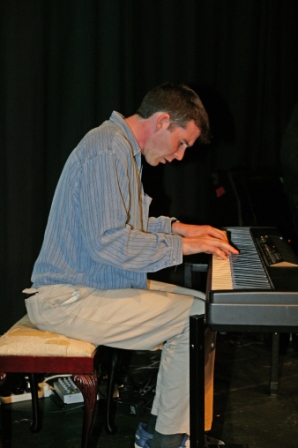
Gwilym Simcock
at 27 is the most outstanding jazz pianist and composer of
his generation. He is also an exceptional Classical repertoire
performer and French horn player. Gwilym attained the highest marks
in the country for his Associated Board Grade 8 exams - on both
piano and French horn - at the age of eleven. After attending Chethams School in Manchester he moved to London, where he studied
piano at The Royal Academy of Music. His teachers there included
John Taylor, Nick Weldon and Geoff Keezer. Gwilym left the Royal
Academy with a first-class honours degree and the coveted
'Principal's Prize' for outstanding achievement.
GWILYM
SIMCOCK TRIO

with Yuri Goloubev (bass) and James Maddren
(drums)
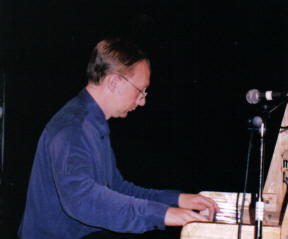 Andy
Quin - Review Andy
Quin - Review
The music was the jazz standard Tiger rag. The pianist a virtuoso, who
one evening last November held a capacity crowd at London’s Cadogan Hall
spellbound. He went on to give electrifying performances of two more jazz
pieces, and was cheered to the rafters. But this was a performance and a concert
with a difference. No surprise in the repertoire: Cadogan Hall gladly hosts jazz
concerts as well as being the London home of the Royal Philharmonic Orchestra.
The surprise was the pianist, Andy Quin. For Quin is not a professional pianist
at all, but a man who makes his living writing music for films, television and
advertising.
Quin’s set had everything: casually but expertly executed Art Tatum-esque runs
up and down the keyboard, a fascinating version of a Coltrane tune - Giant Steps
- with sustained passages of perpetuum mobile, and a Gershwin finale - I Got
Rhythm - in which he astonished the audience by doubling an already nippy tempo
and then doubling it again.’
Andy also has The Estonia Grande Piano and the mighty Hammond A100 with the
Leslie Cabinet in his Studio - some guy's have all the luck eh.
Andy Plays - I Got Rhythm
- UK's Art Tatum - but this time merely myopic - Jazz Eddie -Tiger
Rag -
Art Tatum's
Version
 David
Gordon David
Gordon
John
Horler
Judy
Lewis Group
Tim
Richards
Liam
Noble
Tom
Cawley
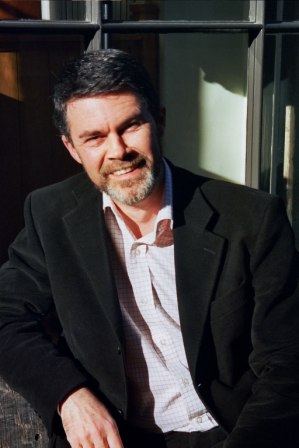 David
Newton Growing up in Renfrewshire,
Scotland, Newton had a musical upbringing with the piano trio sound of Peterson,
Tatum or Garner an ever-present feature in the Newton household. After
graduating from Leeds College of Music in 1979 David Newton freelanced around
Yorkshire and eventually became a resident musician at the Stephen Joseph
Theatre in Scarborough for two and a half years. A move to Edinburgh followed
where theatre work using local musicians quickly led to an established position
on the Scottish jazz scene but after some four years there, his old roommate
from college, Alan Barnes, persuaded him to move to London where he rapidly
became a much sought after pianist teaming up with Barnes, guitarist Martin
Taylor and saxophonist Don Weller. David
Newton Growing up in Renfrewshire,
Scotland, Newton had a musical upbringing with the piano trio sound of Peterson,
Tatum or Garner an ever-present feature in the Newton household. After
graduating from Leeds College of Music in 1979 David Newton freelanced around
Yorkshire and eventually became a resident musician at the Stephen Joseph
Theatre in Scarborough for two and a half years. A move to Edinburgh followed
where theatre work using local musicians quickly led to an established position
on the Scottish jazz scene but after some four years there, his old roommate
from college, Alan Barnes, persuaded him to move to London where he rapidly
became a much sought after pianist teaming up with Barnes, guitarist Martin
Taylor and saxophonist Don Weller.
Newton's recording career had begun in 1985 with Buddy De Franco and Martin
Taylor and his first solo album was released in '88 in association with producer
Elliot Meadow who oversaw the next nine years of recording for Linn Records
followed by Candid Records. Once again, in 1997, David Newton and Alan Barnes
teamed up and together with Concorde Label agent Barry Hatcher, made four CDs
for that label. By 2003, Newton had learned a great deal of the ways a record
company operated and he set up a business partnership with former pupil Mike
Daymond and they established "Brightnewday Records" initially as a vehicle for
Newton's own music but with an eye to opening up the catalogue to other artists
later on.
In the first five years of the nineties, Newton's reputation as an exquisite
accompanist for a singer, spread rather rapidly and by '95 he was regularly
working with Carol Kidd, Marion Montgomery, Tina May, Annie Ross, Claire Martin
and of course Stacey Kent, with whom he spent the next ten years recording and
travelling all over the world. While all this was going on, Newton was composing
music which he would record on his own CDs as well as writing specifically for
Martin Taylor, Alan Barnes, Tina May or Claire Martin and Newton's music can now
be heard on many television productions, especially in the United States where
over twenty TV movies benefit from Newton's haunting themes. In 2003, after a
twenty year gap, David Newton was reunited with playwright Alan Aykbourn having
been involved with eight world premiers in Scarborough and London back in the
early eighties, and he was asked to write the music for two new productions,
'Sugar Daddies' and 'Drowning on Dry Land'. Currently, with the release of a new
CD called "Inspired", on the 'Brightnewday' label, David Newton is relishing the
musical freedom of his Trio and the special sound it makes whilst working on two
other new recording projects, as an arranger and a composer.
David Newton has been voted best Jazz Pianist in the British Jazz awards six
times and was made a Fellow of Leeds College of Music in 2003.
 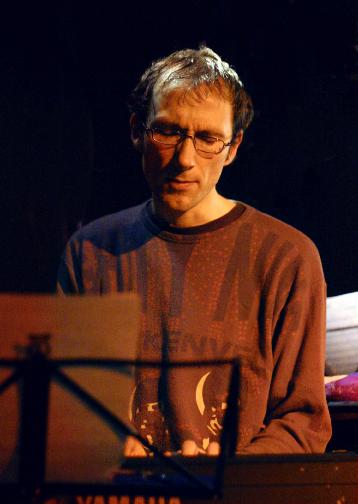 Phil
Peskett is
one of the hottest young names on the London jazz scene. He has played with Jim
Mullen and at Ronnie Scott’s club in London many times with Trudy Kerr, with
whom he has recorded two albums. He has also performed with Stan Sulzman and
Steve Waterman. A tutor on the degree course at the Trinity College of Music, he
is also a respected composer and has his own piano trio which perform at the 606
club regularly. Studied at Leeds College of Music and the Guildhall. Phil
Peskett is
one of the hottest young names on the London jazz scene. He has played with Jim
Mullen and at Ronnie Scott’s club in London many times with Trudy Kerr, with
whom he has recorded two albums. He has also performed with Stan Sulzman and
Steve Waterman. A tutor on the degree course at the Trinity College of Music, he
is also a respected composer and has his own piano trio which perform at the 606
club regularly. Studied at Leeds College of Music and the Guildhall.
Will Bartlett
A graduate of Oxford and The Guildhall School of Music, Will Bartlett is a
sophisticated pianist with a beautiful taste for ballads. His tone is
reminiscent of Bill Evans - a characteristic he uses to his advantage when
accompanying vocalists or lead instruments. Though Will has done a lot of
solo playing, he has another talent with bands having received the award for
'Best Arranger' in last year's BBC Big Band Competition. Will also runs a trio
and quartet that play a range of Jazz genres.
Keith Jarrett - Somewhere over the Rainbow
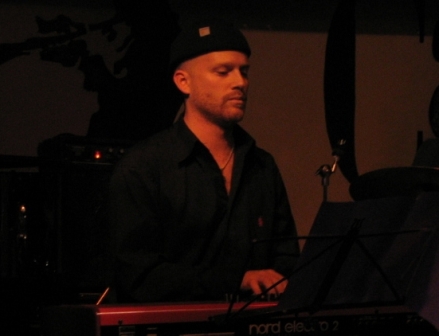 Holger
Skepeneit -
Holger started
playing classical piano at the age of eight and turned to jazz and blues at
fourteen. After finishing school he briefly attended a full-time jazz course in
Frankfurt/Germany. He then came to England to study piano, jazz piano and
composition at the London College of Music, graduating in 2000 with a first
class honours degree. The same year he started and completed successfully an
MMus in jazz piano at the Leeds College of Music. Since graduating he’s been a
sought after pianist, keyboard player, composer and MD. During his career so far
he has performed and recorded along side artists such as Pete King, Jeff Clyne,
Tina May, Alan Barnes, John Wheatcroft, Steve Waterman, Alan Shaw, Mark
Nightingale, Kiranpal Sing, John Surman and many others. Apart from having
played in most of the UK’s major live music venues (including the Southbank,
Cadogan Hall, Shepherds Bush Empire, Peel Bay Festival, and the Wigmore Hall),
he has so far performed in over 20 different countries, in Europe and overseas.
Furthermore Holger has played for the guests of her Majesty the Queen and was
awarded the Westminster prize for improvisation. Apart from being a busy
performer, Holger is quite a prolific composer as well. His first works (for
piano and sax) were published when he was only seventeen. Since then he has
written a variety of highly acclaimed pieces ranging from piano concertos and
string quartets to Big Band pieces, solo piano works and trio suites. At the
moment Holger works mainly with his own trio (with Chris Nicholls on drums and
Alan Mian on bass), the Counterfeit Stones and the Balkan Fusion line-up Dark
Raki (with Vasilis X). He is also part-time tutor for keyboard and theory at the
Institute for Contemporary Music Performance and Thames Valley University). www.myspace.com/holgerskepeneittrio Holger
Skepeneit -
Holger started
playing classical piano at the age of eight and turned to jazz and blues at
fourteen. After finishing school he briefly attended a full-time jazz course in
Frankfurt/Germany. He then came to England to study piano, jazz piano and
composition at the London College of Music, graduating in 2000 with a first
class honours degree. The same year he started and completed successfully an
MMus in jazz piano at the Leeds College of Music. Since graduating he’s been a
sought after pianist, keyboard player, composer and MD. During his career so far
he has performed and recorded along side artists such as Pete King, Jeff Clyne,
Tina May, Alan Barnes, John Wheatcroft, Steve Waterman, Alan Shaw, Mark
Nightingale, Kiranpal Sing, John Surman and many others. Apart from having
played in most of the UK’s major live music venues (including the Southbank,
Cadogan Hall, Shepherds Bush Empire, Peel Bay Festival, and the Wigmore Hall),
he has so far performed in over 20 different countries, in Europe and overseas.
Furthermore Holger has played for the guests of her Majesty the Queen and was
awarded the Westminster prize for improvisation. Apart from being a busy
performer, Holger is quite a prolific composer as well. His first works (for
piano and sax) were published when he was only seventeen. Since then he has
written a variety of highly acclaimed pieces ranging from piano concertos and
string quartets to Big Band pieces, solo piano works and trio suites. At the
moment Holger works mainly with his own trio (with Chris Nicholls on drums and
Alan Mian on bass), the Counterfeit Stones and the Balkan Fusion line-up Dark
Raki (with Vasilis X). He is also part-time tutor for keyboard and theory at the
Institute for Contemporary Music Performance and Thames Valley University). www.myspace.com/holgerskepeneittrio
“...dedicated to a more progressive approach towards contemporary jazz, and
consequently seeks to steer away from the conventional neo-conservative
mainstream be-bop that has become so synonymous with jazz nowadays.”
Tony Cooper, Eastern Daily Press
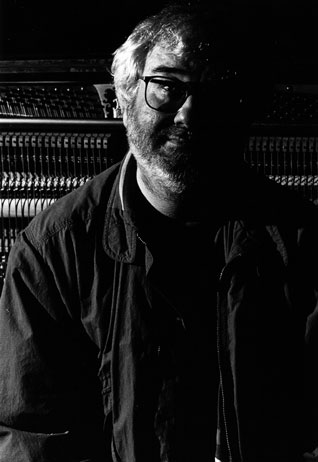 John
Horler - John is a highly
respected pianist and composer who has earned a formidable reputation on
the British jazz scene over many years. His credentials as a musician
are as impeccable as they are diverse. He started studying at the Royal
Academy of Music at the precocious age of sixteen. He acquired his LRAM.
Unlike today, Jazz was not valued or studied at the Academy, so he
didn’t find himself launched onto the jazz scene at an early age. But
his abilities were acknowledged by the Royal Academy at a later stage
when he was made an ARAM for services to music! The route to
success was through pub gigs and appearances on BBC’s Jazz Club, funded
by work as a successful session musician. As his reputation grew he
found himself increasingly supporting American jazz stars, such as Bob
Brookmeyer, Clark Terry, Zoot Sims, Al Cohn, Art Farmer, Pepper Adams,
Bud Shank, and Shorty Rodgers. One of the most memorable of these events
was working with Chet Baker for a week at The Canteen in Great Queen
Street. He worked closely with Pete King, Tommy Whittle, Tony Coe
and the late great Ronnie Ross for many years, playing regularly in
their groups and recording with them. For the last twenty years he has
been first pianist to Sir John Dankworth and Dame Cleo Laine. His most
recent accolade was Critics choice Jazz pianist of the year 2002.
Finally in 1993 he started making his own recordings, highlighting his
own compositions alongside his favourite standard tunes. The first
recording was Lost Keys recorded with Jeff Clyne and
Trevor Tomkins in 1993. The most recent is the new Modern Jazz Trio
album with Sam Burgess and Mike Smith - The Key to it All
released by Divingduck Records in April 2007 John
Horler - John is a highly
respected pianist and composer who has earned a formidable reputation on
the British jazz scene over many years. His credentials as a musician
are as impeccable as they are diverse. He started studying at the Royal
Academy of Music at the precocious age of sixteen. He acquired his LRAM.
Unlike today, Jazz was not valued or studied at the Academy, so he
didn’t find himself launched onto the jazz scene at an early age. But
his abilities were acknowledged by the Royal Academy at a later stage
when he was made an ARAM for services to music! The route to
success was through pub gigs and appearances on BBC’s Jazz Club, funded
by work as a successful session musician. As his reputation grew he
found himself increasingly supporting American jazz stars, such as Bob
Brookmeyer, Clark Terry, Zoot Sims, Al Cohn, Art Farmer, Pepper Adams,
Bud Shank, and Shorty Rodgers. One of the most memorable of these events
was working with Chet Baker for a week at The Canteen in Great Queen
Street. He worked closely with Pete King, Tommy Whittle, Tony Coe
and the late great Ronnie Ross for many years, playing regularly in
their groups and recording with them. For the last twenty years he has
been first pianist to Sir John Dankworth and Dame Cleo Laine. His most
recent accolade was Critics choice Jazz pianist of the year 2002.
Finally in 1993 he started making his own recordings, highlighting his
own compositions alongside his favourite standard tunes. The first
recording was Lost Keys recorded with Jeff Clyne and
Trevor Tomkins in 1993. The most recent is the new Modern Jazz Trio
album with Sam Burgess and Mike Smith - The Key to it All
released by Divingduck Records in April 2007
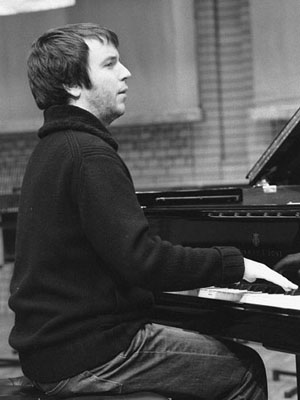 Frank
Harrison, Piano Frank
Harrison, Piano
Frank Harrison was born in Oxford on 8
July 1978. He took up the piano at 11, and began playing gigs when he
was 15. In 1994 he won the soloist award in the Daily Telegraph Young
Jazz Competition, and in 1996 placed second in Young Jazz Musician Of
The Year. After taking up a scholarship at Berklee School Of
Music, Boston, he returned to England and joined Gilad Atzmon's band. In
2000 they started the Orient House Ensemble, with whom Frank has
recorded four albums on Enja Records, including BBC Jazz Album Of The
Year 2003, "Exile". The band regularly tours Europe, playing at major
Jazz and World music festivals. Frank has also performed with
Peter
King, Julian Siegel, Don
Weller, Alan Barnes,
John Etheridge,
Louis Stewart
and Iain Ballamy.
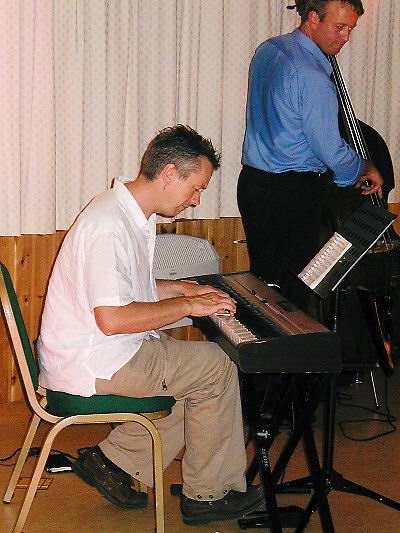 Clive Dunstall Clive Dunstall
Clive
has performed as a pianist for The Queen onboard The Royal Yacht
Britannia (during his service in the Royal Marines Band) and has
appeared on several occasions as a soloist on 'Friday Night is Music
Night'. During his career to date, Clive has been a member
of The National Youth Jazz Orchestra. The Glenn Miller
Orchestra UK, The Syd Lawrence Orchestra and has occasionally appeared
with The BBC Big Band. He has worked with some of the
country's leading orchestras including the London Symphony Orchestra,
The Royal Philharmonic Orchestra, The City of Birmingham Symphony
Orchestra, The London Sinfonietta and The Ulster Orchestra.
In the West end he was the Musical director of 'Five Guys Named Moe',
Assistant MD on 'Our House', 'Smokey Joe's Cafe' and led the jazz group
on 'Lenny ' with Eddie Izzard. On tour he has Musically
Directed Matthew Bourne's 'Play Without Words', (Japan) Shall We Dance',
(Europe)'Fame', (Norway, Sweden)'Grease', (Norway, Finland) 'The Rat
Pack' UK and has toured with Jack Jones, Michael Ball and Sister Sledge.
  Tim
Lapthorne Tim
Lapthorne
Originally from Cambridge, Tim has studied French & Philosophy at Leeds
University & then completed the one year Postgrad Jazz course at the
Guildhall School of Music. He now teaches piano privately from home &
performs regularly in & around London. His exciting new trio with Tom
Herbett (bass) & Pat Levett (drums) has just released it's first album
"Outlines", containing six original compositions by Tim. The music has a
strong focus on openness, interplay & flow, the themes being simple &
melodic.
Geoff Eales Pianis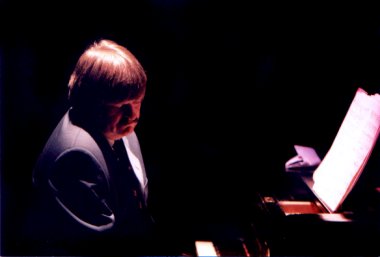 t t
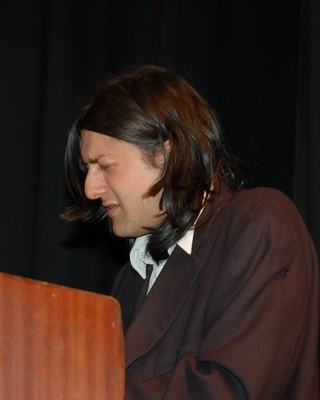 Leon Greening
- Piano Leon Greening
- Piano
Pianist Leon Greening studied
at Leeds College of Music and the Guildhall.
His extraordinary solos, inspired by the
likes of Wynton Kelly and Bud Powell, keep the audience on the edge of their
seats and mark him out, at the age of only 31, as one of the finest pianists
this country has ever produced. An all star gig absolutely not to be missed.
He was voted runner-up in the 1999
Sun Alliance Musician of the Year awards.
He has performed at Ronnie Scott's and
with Christian Brewer Quartet, Matt Wates Sextet, Gareth Lockrane Septet and
toured with pop band 'Incognito'.
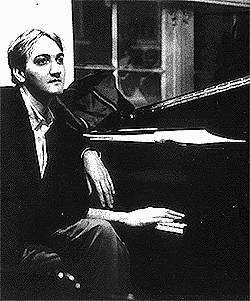 GRAHAM
HARVEY (Mayhem Garvey) GRAHAM
HARVEY (Mayhem Garvey)
Graham is a fine keyboard player who, although perhaps best known for
his work with the acid jazz group “Incognito”, is also a very impressive
modern jazz pianist. Yet another of the players who studied in America,
Graham is generally recognised as one of the finest players of his
generation. He is appears with his “All Star” band, featuring four of
Europe’s greatest musicians, award winning trombonist
Mark Nightingale,
Laurence Cottle-bass,
Ian Thomas-drums
and special guest
Nigel Hitchcock-sax.
This is a “super group” if ever there was one.
Albums include George
Benson, Incognito, Sax Appeal. Roadside Picnic, Bobby Wellins, Maysa
Leak, Derek Nash Quartet. Has worked with Stevie Wonder, Ronnie Laws.
Clark Terry, Warren Vache, Spike Robinson. Toured U.S.A, Europe and
Japan as keyboard player and musical director for Incognito also
composed and played on 7 of their albums. He also appears on Hamish
Stewart's recent album with Jim Mullen. For the last couple of years he
has been playing in various west end musicals. He has produced and
played on an album now due for release which includes Ed Jones and Jim
Mullen. He has played with his trio at such venues as the 606 club and
the Festival Hall foyer as well as various solo appearances. He has
played with the BBC. Big Band and Lawrence Cottle Big Band at Ronnie
Scotts and Brecon Jazz Festival also occasional chair with the Back to
Basie Orchestra . Graham is at present preparing an Album for his own
Trio. B.Mus Honours University of Denver.U.S.A
Simon Colam - piano
Simon was born in Lancashire and studied at Salford University before
moving on to undergraduate classical and jazz studies at the Guildhall
School of Music and Drama.
He was one of the first to graduate from the combined classical/jazz
degree course. He performs in various groups ('Gato
Loco') and often works with vocalists.
Since
then he has developed a career in live and studio music concentrating on
jazz, salsa and commercial music and has performed in many of the major
venues in the UK including the Royal Festival Hall, Barbican Centre,
Earls Court and Wembley Arena. Simon is keyboard player for NZ
saxophonist Nathan Haines, Mercury Music Prize nominated London MC Ty,
Robert Miles, Theo Travis, Dave O'Higgins and vocalist David Tughan,
touring with them in Europe, South Africa and Japan. He is also a member
of the Big Blue band, which was featured on the Pop Idol TV Series and
arena tour as well as accompanist for ITV's X Factor and BBC's Fame
Academy series. Simon is head of Jazz at The Purcell School and teaches
at the Royal Academy of Music Junior Dept.
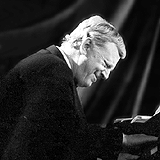 UK
Pioneer Brian Dee is one of England's leading jazz pianists. He first
came to prominence with the opening of the Ronnie Scott Club in 1959.
His international reputation grew and he toured as a member of The Jazz
Five opposite Miles Davis. In 1965 was voted "Melody Maker New Star". UK
Pioneer Brian Dee is one of England's leading jazz pianists. He first
came to prominence with the opening of the Ronnie Scott Club in 1959.
His international reputation grew and he toured as a member of The Jazz
Five opposite Miles Davis. In 1965 was voted "Melody Maker New Star".
Dee's working experience
as an accompanist of world class vocalists is well known. The list of
jazz stars that he has worked with is endless and includes recording
with Bing Crosby, Johnny Mercer, Peggy Lee and Fred Astaire.
He is still making frequent appearances at Ronnie Scott's and broadcasts
regularly on radio with his own trio.
-
The outstanding
feature of Dee's performance here, is its fleetness of fingering and
cleanness of articulation. Russell Davies, Daily Telegraph
-
Dee's qualities,
delicacy, flexibility, wit and ingenuity soon make themselves
apparent. Dave Gelly The Observer
-
Brian Dee's Trio was
perfect ... amongst the best of our jazz pianists, and probably one
of the best accompanists we have ever had.
Steve Voce Jazz Journal
 Grant
Windsor - After
achieving his A.Mus.A on flute he moved on to study piano,
conducting and composition at the West Australian Academy of
Performing Arts. Grant
Windsor - After
achieving his A.Mus.A on flute he moved on to study piano,
conducting and composition at the West Australian Academy of
Performing Arts.During
his time at the Academy Grant studied with many artists such
as Brian Howard, Steve Williams, Graeme Lyall, Mark Levine,
Frank Foster and Paul Grabowsky. In 1999 Grant was one of
five pianists selected for a place in the National Academy
of Music in Melbourne and it was here that he studied with
Mick Nock and Dr Tony Gould, as well as performing with some
of the Australia's jazz legends.
Since completing his Bachelor
of Music in December 2000, Grant has performed with many
artists including Frank Foster, Sandy Evans, Sarah and Leila Petronio, Don Burrows, James Morrison, Janet Seidel and
Randy Brecker.
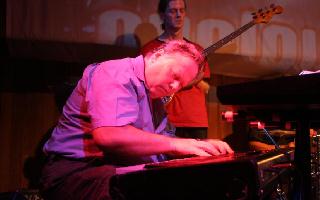 Geoff
Castle
- Pianist and composer Geoff Castle has played with top
names on the British jazz scene since 1970. He was born in
North London in 1949. His father was a photographer, his
mother a social worker. Both parents were musical and he
started piano lessons at the age of 8. He joined the
National Youth Jazz Orchestra in 1967 with whom he toured
nationally and visited France and Bulgaria. After leaving
NYJO in 1970 he joined Graham Collier's septet which starred
at the 1971 Montreux festival winning two prizes. Geoff has
featured in both acoustic and electric jazz and he joined
Ian Carr's Nucleus in 1974 playing electric piano and Moog.
He played with this band for eight years and appeared on six
albums and many European tours. The band played at the first
Jazz Yatra in Bombay in 1977 Geoff
Castle
- Pianist and composer Geoff Castle has played with top
names on the British jazz scene since 1970. He was born in
North London in 1949. His father was a photographer, his
mother a social worker. Both parents were musical and he
started piano lessons at the age of 8. He joined the
National Youth Jazz Orchestra in 1967 with whom he toured
nationally and visited France and Bulgaria. After leaving
NYJO in 1970 he joined Graham Collier's septet which starred
at the 1971 Montreux festival winning two prizes. Geoff has
featured in both acoustic and electric jazz and he joined
Ian Carr's Nucleus in 1974 playing electric piano and Moog.
He played with this band for eight years and appeared on six
albums and many European tours. The band played at the first
Jazz Yatra in Bombay in 1977
He plays regularly at Ronnie
Scott's with tenor player Stan Robinson and has accompanied visiting artists
including US jazzmen George Coleman, Jimmy Giuffre, James Moody and Art Farmer
well as appearing with his own line-ups. British bands he has worked with
include Morrissey Mullen, Ian Dury, Sax Appeal and Georgie Fame. He has also
worked in several cross-over Irish folk and jazz projects with NZ harmonica
player Brendan Power. In addition to freelance work on the London jazz
scene Geoff features with his acoustic trio with Gary Crosby and Daniel Crosby.
He also appears with Frank Holder and Stan Robinson with Castle Frank'n'Stan. He
also makes regular concerts with Geoff Castle's Latinesque and Paz.
Local Tuition for Piano
and Keyboards
 Chiltern Music
Services & Studio Chiltern Music
Services & Studio
Tuition, Sales, Service - email
Alan Peppett Walters Ash, nr High Wycombe, Bucks
- for beginners or
improvers 01494 562 048
|
 Grant
Windsor - After
achieving his A.Mus.A on flute he moved on to study piano,
conducting and composition at the West Australian Academy of
Performing Arts.
Grant
Windsor - After
achieving his A.Mus.A on flute he moved on to study piano,
conducting and composition at the West Australian Academy of
Performing Arts. Geoff
Castle
- Pianist and composer Geoff Castle has played with top
names on the British jazz scene since 1970. He was born in
North London in 1949. His father was a photographer, his
mother a social worker. Both parents were musical and he
started piano lessons at the age of 8. He joined the
National Youth Jazz Orchestra in 1967 with whom he toured
nationally and visited France and Bulgaria. After leaving
NYJO in 1970 he joined Graham Collier's septet which starred
at the 1971 Montreux festival winning two prizes. Geoff has
featured in both acoustic and electric jazz and he joined
Ian Carr's Nucleus in 1974 playing electric piano and Moog.
He played with this band for eight years and appeared on six
albums and many European tours. The band played at the first
Jazz Yatra in Bombay in 1977
Geoff
Castle
- Pianist and composer Geoff Castle has played with top
names on the British jazz scene since 1970. He was born in
North London in 1949. His father was a photographer, his
mother a social worker. Both parents were musical and he
started piano lessons at the age of 8. He joined the
National Youth Jazz Orchestra in 1967 with whom he toured
nationally and visited France and Bulgaria. After leaving
NYJO in 1970 he joined Graham Collier's septet which starred
at the 1971 Montreux festival winning two prizes. Geoff has
featured in both acoustic and electric jazz and he joined
Ian Carr's Nucleus in 1974 playing electric piano and Moog.
He played with this band for eight years and appeared on six
albums and many European tours. The band played at the first
Jazz Yatra in Bombay in 1977


 His
publicity photos claimed he was the 'originator of jazz and stomps', an example
of the kind of outrageous and colourful statement frequently associated with
this most colourful of jazz characters. Morton was born in New Orleans, and he
grew up in that City's creole society.
His
publicity photos claimed he was the 'originator of jazz and stomps', an example
of the kind of outrageous and colourful statement frequently associated with
this most colourful of jazz characters. Morton was born in New Orleans, and he
grew up in that City's creole society. Thomas
Wright (1904-1943) Pianist, organist, singer, bandleader, and composer
Thomas
Wright (1904-1943) Pianist, organist, singer, bandleader, and composer
 WILSON,
THEODORE SHAW (1912-1986). Teddy Wilson,
jazz pianist, was born in Austin, Texas, on November 24, 1912, the second son of
James and Pearl Wilson. In 1918 he and his family moved to Tuskegee, Alabama,
where his mother worked as a librarian and his father taught English at the
Tuskegee Institute. Wilson attended the institute, where he studied piano and
violin; he also played the E-flat clarinet and oboe in the school band. He
attended Talladega College for a year, but moved to Detroit in 1929 to earn his
living as a musician. Wilson played in a band with Speed Webb in the Detroit
area from 1929 to 1931. In 1931 he moved to Chicago, where he had the good
fortune to play alongside Erskine Tate, Louis Armstrong, and Jimmy Noone. He
joined the Benny Carter band in 1933 and made several recordings. Wilson's big
break came in 1936, when he began touring with Benny Goodman and Gene Krupa,
making the trio one of the first interracial groups to perform in the United
States. Crowds at that time cheered Wilson on the bandstand, but he still had to
stay at the "colored" hotels. Between 1935 and 1939 Wilson also performed with
soloists from the Count Basie and Duke Ellington bands, as well as with vocalist
Billie Holiday; during this time he recorded on the Brunswick label. He formed
his own band and worked with CBS studios in the 1940s and 1950s, and he taught
piano at the Juilliard School of Music from 1945 to 1952. He also appeared in
The Seven Lively Arts and in the movie The Benny Goodman Story
(1956). Wilson brought to jazz an elegance and sophistication that it had not
previously enjoyed. He drew elements from Fats Waller, Earl Hines, and Art
Tatum, blending and refining them into his own unique sound. His style was
subtle and disciplined, providing an effective contrast when he accompanied
artists like Billie Holiday, who usually sang just outside the beat.
Characteristics of Wilson's music included short, single-note phrases, tenth
chords in the left hand, and a wonderfully provocative use of dissonance. His
talent at improvisation let him create intricate counterpoint lines that
complimented whichever soloist he was performing with. Wilson rejoined Benny
Goodman's group for tours of Scandinavia in 1952, England in 1953, Australia in
1960, Europe in 1965, several trips to Japan in the 1970s, and a concert at
Carnegie Hall in 1982. He died on July 31, 1986, in New Britain, Connecticut,
after a lengthy illness.
WILSON,
THEODORE SHAW (1912-1986). Teddy Wilson,
jazz pianist, was born in Austin, Texas, on November 24, 1912, the second son of
James and Pearl Wilson. In 1918 he and his family moved to Tuskegee, Alabama,
where his mother worked as a librarian and his father taught English at the
Tuskegee Institute. Wilson attended the institute, where he studied piano and
violin; he also played the E-flat clarinet and oboe in the school band. He
attended Talladega College for a year, but moved to Detroit in 1929 to earn his
living as a musician. Wilson played in a band with Speed Webb in the Detroit
area from 1929 to 1931. In 1931 he moved to Chicago, where he had the good
fortune to play alongside Erskine Tate, Louis Armstrong, and Jimmy Noone. He
joined the Benny Carter band in 1933 and made several recordings. Wilson's big
break came in 1936, when he began touring with Benny Goodman and Gene Krupa,
making the trio one of the first interracial groups to perform in the United
States. Crowds at that time cheered Wilson on the bandstand, but he still had to
stay at the "colored" hotels. Between 1935 and 1939 Wilson also performed with
soloists from the Count Basie and Duke Ellington bands, as well as with vocalist
Billie Holiday; during this time he recorded on the Brunswick label. He formed
his own band and worked with CBS studios in the 1940s and 1950s, and he taught
piano at the Juilliard School of Music from 1945 to 1952. He also appeared in
The Seven Lively Arts and in the movie The Benny Goodman Story
(1956). Wilson brought to jazz an elegance and sophistication that it had not
previously enjoyed. He drew elements from Fats Waller, Earl Hines, and Art
Tatum, blending and refining them into his own unique sound. His style was
subtle and disciplined, providing an effective contrast when he accompanied
artists like Billie Holiday, who usually sang just outside the beat.
Characteristics of Wilson's music included short, single-note phrases, tenth
chords in the left hand, and a wonderfully provocative use of dissonance. His
talent at improvisation let him create intricate counterpoint lines that
complimented whichever soloist he was performing with. Wilson rejoined Benny
Goodman's group for tours of Scandinavia in 1952, England in 1953, Australia in
1960, Europe in 1965, several trips to Japan in the 1970s, and a concert at
Carnegie Hall in 1982. He died on July 31, 1986, in New Britain, Connecticut,
after a lengthy illness.
 Art
Tatum was born Oct. 13, 1909 in Toledo, Ohio and despite
being blind in one eye and only partially sighted in the other he became
arguably the greatest jazz piano player who ever lived. The
starting point of Art Tatum's style was Fats Waller's stride. As Tatum once
said, "Fats, that's where I come out of and, man, that's quite a place to come
from". From this beginning he went on to create and superbly original and
creative style of playing piano. His left-handed figures where similar to
stride but he was really known for the way that he explored harmonic
complexities and unusual chord progressions. When improvising, Tatum would
often insert totally new chord sequences (occasionally with a chord on each
beat) into one or two measures. He also developed the habit of quoting from
other melodies, something that became a standard practice among modern jazz
musicians. What really set Tatum apart was his amazing technical abilities
which combined with his willingness to explore the imagined limitations of the
orthodox keyboard which produced astonishing rhythmic and harmonic
complexities. It is claimed that he could identify the dominant note in a
flushing toilet. Perhaps the greatest tribute to the excellence of Art Tatum
lies in the opinions of his peers. His influenced many musicians including Bud
Powell, Herbie Hancock, and even non-pianists such as Charlie Parker and John
Coltrane. Many would say that he inspired the bebop revolution in jazz. When
Oscar Peterson first heard him play he thought it was two people and he
considered Tatum the best jazz instrumentalist of all time. Legend has it that
classical pianist Vladimir Horowitz was so awed by Tatum's wizardry that it
brought him to tears. Fittingly, his strongest support comes from one of his
early influences, Fats Waller. One time in 1938 Tatum dropped in to hear Waller
play at a club. By way of introduction Waller told the audience, "I just play
the piano, but God is in the house tonight."
Art
Tatum was born Oct. 13, 1909 in Toledo, Ohio and despite
being blind in one eye and only partially sighted in the other he became
arguably the greatest jazz piano player who ever lived. The
starting point of Art Tatum's style was Fats Waller's stride. As Tatum once
said, "Fats, that's where I come out of and, man, that's quite a place to come
from". From this beginning he went on to create and superbly original and
creative style of playing piano. His left-handed figures where similar to
stride but he was really known for the way that he explored harmonic
complexities and unusual chord progressions. When improvising, Tatum would
often insert totally new chord sequences (occasionally with a chord on each
beat) into one or two measures. He also developed the habit of quoting from
other melodies, something that became a standard practice among modern jazz
musicians. What really set Tatum apart was his amazing technical abilities
which combined with his willingness to explore the imagined limitations of the
orthodox keyboard which produced astonishing rhythmic and harmonic
complexities. It is claimed that he could identify the dominant note in a
flushing toilet. Perhaps the greatest tribute to the excellence of Art Tatum
lies in the opinions of his peers. His influenced many musicians including Bud
Powell, Herbie Hancock, and even non-pianists such as Charlie Parker and John
Coltrane. Many would say that he inspired the bebop revolution in jazz. When
Oscar Peterson first heard him play he thought it was two people and he
considered Tatum the best jazz instrumentalist of all time. Legend has it that
classical pianist Vladimir Horowitz was so awed by Tatum's wizardry that it
brought him to tears. Fittingly, his strongest support comes from one of his
early influences, Fats Waller. One time in 1938 Tatum dropped in to hear Waller
play at a club. By way of introduction Waller told the audience, "I just play
the piano, but God is in the house tonight."

 Tatum was playing professionally
in Toledo by 1926 and performed on radio in 1929-30. In 1932, he travelled to
New York as the accompanist for Adelaide Hall. There, in March 1933, he made his
first solo recordings, for Brunswick. After leaving Hall, he worked in Cleveland
from 1934-5 and led a group in Chicago from 1935-6. His reputation as an
outstanding jazz pianist was consolidated in 1937 with his performances in
various New York clubs and on radio shows. He toured England the following year
and appeared regularly in New York and Los Angeles in the late 1930s and early
1940s. Taking Nat "King" Cole's successful jazz trio as a model, Tatum founded
his own influential trio with Slam Stewart (double bass) and Tiny Grimes
(electric guitar) in 1943. Grimes left the following year, but Tatum continually
returned to this format, playing with Everett Barksdale in particular.
Tatum was playing professionally
in Toledo by 1926 and performed on radio in 1929-30. In 1932, he travelled to
New York as the accompanist for Adelaide Hall. There, in March 1933, he made his
first solo recordings, for Brunswick. After leaving Hall, he worked in Cleveland
from 1934-5 and led a group in Chicago from 1935-6. His reputation as an
outstanding jazz pianist was consolidated in 1937 with his performances in
various New York clubs and on radio shows. He toured England the following year
and appeared regularly in New York and Los Angeles in the late 1930s and early
1940s. Taking Nat "King" Cole's successful jazz trio as a model, Tatum founded
his own influential trio with Slam Stewart (double bass) and Tiny Grimes
(electric guitar) in 1943. Grimes left the following year, but Tatum continually
returned to this format, playing with Everett Barksdale in particular.
 Born
Nathaniel Adams Coles on March 17, 1919 (although 1916 and 1917 have also been
cited), in Montgomery, Alabama, Cole was born into a family with a pivotal
position in the black community; his father was pastor of the First Baptist
Church. In 1921, the family migrated to Chicago, part of the mass exodus seeking
a better life in the prospering industrial towns of the north. At four years
old, he was learning the piano by ear from his mother, a choir director in the
church. At 12 years old he took lessons in classical piano, but was soon to be
bitten by the Jazz bug -- inescapable in Chicago. He left school at 15 to pursue
a career as a jazz pianist. Cole's first professional break came touring in the
revival of the show "Shuffle Along." When the show folded he was stranded in Los
Angeles. Cole looked for club work and found it at the Century Club on Santa
Monica Boulevard, where he made quite an impression.
Born
Nathaniel Adams Coles on March 17, 1919 (although 1916 and 1917 have also been
cited), in Montgomery, Alabama, Cole was born into a family with a pivotal
position in the black community; his father was pastor of the First Baptist
Church. In 1921, the family migrated to Chicago, part of the mass exodus seeking
a better life in the prospering industrial towns of the north. At four years
old, he was learning the piano by ear from his mother, a choir director in the
church. At 12 years old he took lessons in classical piano, but was soon to be
bitten by the Jazz bug -- inescapable in Chicago. He left school at 15 to pursue
a career as a jazz pianist. Cole's first professional break came touring in the
revival of the show "Shuffle Along." When the show folded he was stranded in Los
Angeles. Cole looked for club work and found it at the Century Club on Santa
Monica Boulevard, where he made quite an impression. George
Shearing enjoys an international reputation as a pianist, arranger, and
composer. Equally at home on the concert stage as in jazz clubs, Shearing is
recognised for inventive, orchestrated jazz. He has written over 300
compositions, including the classic “Lullaby of Birdland”, which has become a
jazz standard.
George
Shearing enjoys an international reputation as a pianist, arranger, and
composer. Equally at home on the concert stage as in jazz clubs, Shearing is
recognised for inventive, orchestrated jazz. He has written over 300
compositions, including the classic “Lullaby of Birdland”, which has become a
jazz standard.

 Thelonious
Sphere Monk (1917-1982) is recognized as one of the most influential figures
in the history of Jazz. He was one of the architects of bebop and his impact as
a composer and pianist has had a profound influence on every genre of music.
Monk was born on October 10, 1917, in Rocky Mount, North Carolina, but his
parents, Barbara Batts and Thelonious Monk, soon moved the family to New York
City. Monk began piano lessons as a young child and by the age of 13 he had won
the weekly amateur contest at the Apollo Theater so many times that he was
barred from entering. At the age of 19, Monk joined the house band at Minton's
Playhouse in Harlem, where along with Charlie Parker, Dizzy Gillespie, and a
handful of other players, he developed the style of jazz that came to be known
as bebop. Monk's compositions, among them "Round Midnight," were the canvasses
over which these legendary soloists expressed their musical ideas. In 1947, Monk
made his first recordings as a leader for Blue Note. These albums are some of
the earliest documents of his unique compositional and improvisational style,
both of which employed unusual repetition of phrases, an offbeat use of space,
and joyfully dissonant sounds. That same year, he married his long-time love
Nellie Smith and later had two children, Thelonious, Jr. and Barbara
(1954-1984). In the decade that followed, Monk played on recordings with Miles
Davis, Charlie Parker, and Sonny Rollins and recorded as a leader for Prestige
Records and later for Riverside Records. Brilliant Corners and
Thelonious Monk with John Coltrane were two of the albums from this period
that brought Monk international attention as a pianist and composer.
Thelonious
Sphere Monk (1917-1982) is recognized as one of the most influential figures
in the history of Jazz. He was one of the architects of bebop and his impact as
a composer and pianist has had a profound influence on every genre of music.
Monk was born on October 10, 1917, in Rocky Mount, North Carolina, but his
parents, Barbara Batts and Thelonious Monk, soon moved the family to New York
City. Monk began piano lessons as a young child and by the age of 13 he had won
the weekly amateur contest at the Apollo Theater so many times that he was
barred from entering. At the age of 19, Monk joined the house band at Minton's
Playhouse in Harlem, where along with Charlie Parker, Dizzy Gillespie, and a
handful of other players, he developed the style of jazz that came to be known
as bebop. Monk's compositions, among them "Round Midnight," were the canvasses
over which these legendary soloists expressed their musical ideas. In 1947, Monk
made his first recordings as a leader for Blue Note. These albums are some of
the earliest documents of his unique compositional and improvisational style,
both of which employed unusual repetition of phrases, an offbeat use of space,
and joyfully dissonant sounds. That same year, he married his long-time love
Nellie Smith and later had two children, Thelonious, Jr. and Barbara
(1954-1984). In the decade that followed, Monk played on recordings with Miles
Davis, Charlie Parker, and Sonny Rollins and recorded as a leader for Prestige
Records and later for Riverside Records. Brilliant Corners and
Thelonious Monk with John Coltrane were two of the albums from this period
that brought Monk international attention as a pianist and composer. 







 Frank
Harrison, Piano
Frank
Harrison, Piano Clive Dunstall
Clive Dunstall


 Leon Greening
Leon Greening GRAHAM
HARVEY (Mayhem Garvey)
GRAHAM
HARVEY (Mayhem Garvey) UK
Pioneer Brian Dee is one of England's leading jazz pianists. He first
came to prominence with the opening of the Ronnie Scott Club in 1959.
His international reputation grew and he toured as a member of The Jazz
Five opposite Miles Davis. In 1965 was voted "Melody Maker New Star".
UK
Pioneer Brian Dee is one of England's leading jazz pianists. He first
came to prominence with the opening of the Ronnie Scott Club in 1959.
His international reputation grew and he toured as a member of The Jazz
Five opposite Miles Davis. In 1965 was voted "Melody Maker New Star". Chiltern Music
Services & Studio
Chiltern Music
Services & Studio